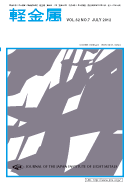巻号一覧

62 巻, 10 号
選択された号の論文の5件中1~5を表示しています
- |<
- <
- 1
- >
- >|
研究論文
-
佐藤 芳輝, 阿相 英孝, 小野 幸子原稿種別: 研究論文
2012 年 62 巻 10 号 p. 357-362
発行日: 2012/10/30
公開日: 2012/11/30
ジャーナル フリーThe effects of electrolyte species and electrolytes combination during two-step anodization of anodic oxide films formed on aluminum in relation to the crystallinity and dielectric properties as an electrolytic capacitor was investigated. Aluminum substrate was pre-treated by dipping in boiling water to form hydration layer. Anodic films were annealed at 500°C after the first anodization. The CV (capacitance C multiplied by withstand voltage V of the film) of the films formed by the second anodization in borate was higher than that of the films formed in the same electrolyte of the first anodization. The CV increased due to the improvement of crystallinity by using borate for second anodization in the following order: salicylate<succinate<tartrate<phosphate<citrate<adipate<borate. When phosphate or organic electrolytes were used at the second anodization, notable spike noises were found. However, the spike noises were significantly suppressed when borate was used as the second anodization.抄録全体を表示PDF形式でダウンロード (2347K) -
渡辺 翼, 本村 貢, 萩原 明夫, 小西 玄太原稿種別: 研究論文
2012 年 62 巻 10 号 p. 363-369
発行日: 2012/10/30
公開日: 2012/11/30
ジャーナル フリーThe cases of the Li-ion batteries mouthed in EV (Electric Vehicles) and FCV (Fuel Cell Vehicles) are conventionally produced by multistage deep drawing. This forming process requires a large number of stages and is expensive. In this study, cold backward (impact extrusion) was adopted since it has very high productivity comparing to conventional process. However, the defects, such as cracks, distortion and uneven thickness will arise in produced cases. The generation mechanism and how to deal with those defects were investigated in this paper. From the experimental results, it was assumed that bending and twisting elastic deformation of dies are cause of the defects. It was found that the case of the deformation is in the heterogeneity state of the lubrication. The punch bottom geometry which can minimize the influence the heterogeneity of the lubrication in the last phase of forming was investigated. In order to reduce the wear of lubricant at high reduction of area, lubricant and surface treatment were also investigated.抄録全体を表示PDF形式でダウンロード (6682K) -
高谷 謙斗, 原田 陽平, 熊井 真次, 北山 健二原稿種別: 研究論文
2012 年 62 巻 10 号 p. 370-376
発行日: 2012/10/30
公開日: 2012/11/30
ジャーナル フリー2024-T3 aluminum alloy studs were welded to 6N01-T6 aluminum alloy plates by using an advanced high-speed solid-state joining method. Plastic deformation of a projection was promoted with increasing discharge voltage. As the result, joining area and joint strength increased. Fracture stress was about 300 MPa in all discharge voltage. In the case of thin plate, the outside region was subjected to higher temperature than the inside region, which caused asymmetrical deformation. In contrast, the deformation was symmetrical in the case of thick plate, because temperature similarly rose in both inside and outside. This resulted in the increased joining area and joint strength with increasing plate thickness. Vickers hardness profile was also measured across the weld interface. The softened zone was appeared at the 6N01-T6 aluminum alloy plate adjacent to the weld interface. Hardness of the softened zone was recovered to that of 6N01-T6 aluminum alloy after post-weld aging. This result indicated that softening was caused by dissolving β″precipitates in the aluminum matrix due to the welding heat input.抄録全体を表示PDF形式でダウンロード (8169K) -
商 芳妮, 関谷 英治, 中山 栄浩原稿種別: 研究論文
2012 年 62 巻 10 号 p. 377-382
発行日: 2012/10/30
公開日: 2012/11/30
ジャーナル フリーA commercial 6061 aluminum alloy bar was partially reinforced using a high-frequency induction heating apparatus. One end of the bar was locally heated for solution treatment (local solution treatment). The power supplied to a heating coil was adjusted based on the surface temperature of the bar, which was measured using a radiation thermometer. The temperature profiles and hardness distributions in the longitudinal direction were investigated after the local solution treatment. The results of this study are as follows. The local solution treatment achieved a rapid heating rate of 80 K/s, overheating of about 2 K at the temperature transition stage from the heating to holding process, and a small-scale temperature fluctuation (below ±8 K) in the holding process. The reproducibility of the temperature profile during the local solution treatment was also sufficient. An increase in the hardness was achieved from solution treatment at 723 K or more. A holding time of 5 min or more was not very important for increasing in the hardness. The partial reinforcement of a 6016 aluminum alloy bar can be realized by applying an induction heating apparatus.抄録全体を表示PDF形式でダウンロード (3075K)
解説:軽金属学会賞
-
茂木 徹一原稿種別: 解説:軽金属学会賞
2012 年 62 巻 10 号 p. 383-389
発行日: 2012/10/30
公開日: 2013/01/30
ジャーナル フリーPDF形式でダウンロード (13044K)
- |<
- <
- 1
- >
- >|